Wireless Electromagnetic Radiation Assessment Based on the Specific Absorption Rate (SAR): A Review Case Study
Abstract
1. Introduction
2. Radio Frequency Hazards
3. SAR (Specific Absorption Rate) Definitions
4. Safety Standards and Organisations
- The National Radiological Protection Board of the United Kingdom (NRPB). On both ionising and non-ionising radiation, the NRPB serves as a statutory adviser to the Health and Safety Commission and was one of the first to suggest a limit based on SAR [42].
- In [43], the European Committee for Electrotechnical Standardisation (CENELEC) published detailed specifications for evaluating human exposure to electromagnetic fields.
- The American National Standards Institute (ANSI) is a non-profit organisation. Until recently, the C95.1 committee was run by ANSI, but it is currently run by the American Institute of Electrical and Electronic Engineers (IEEE). The ANSI-IEEE document [44], which was first published in 1991 and modified in 1999, is the American standard for exposure limits. The most recent edition of this standard was published in 2019 [45].
- The International Radiation Protection Association’s (IRPA’s) International Non-Ionising Radiation Committee (INIRC). This organisation has been in existence for quite some time. In May 1991, IRPA announced the formation of an International Commission on Non-ionising Radiation Protection (ICNIRP), whose objective is to investigate the risks posed by all types of non-ionising radiations. IRPA is a non-governmental and non-political association of professional societies dealing with ionising and non-ionising radiation protection. In 1996, the ICNIRP released the “Guidelines for Limiting Exposure to Time-Varying Electric, Magnetic, and Electromagnetic Fields (up to 300 GHz)” [46], which was updated in 1998. In the year 2020, an updated version of this guidance was published.
- The European Communities’ Commission. The European Economic Community (EEC) Commission is currently drafting radiation protection rules, including the directive for the protection of workers against the risks of physical agents exposure and the machine safety directive. Radiation includes both ionising and non-ionising radiation [47].
- The World Health Organisation (WHO). CENELEC and ANSI/IEEE [41] have both established standards for workers and the general public, commonly known as regulated and uncontrolled environments. In general, controlled settings are places where people are exposed to their knowledge (workers, employed people), while the uncontrolled environments are places in which the exposure caused to individuals occurs without their knowledge or control (general public).
5. Investigations of the Specific Absorption Rate
- -
- At 835 MHz, a compressed pinna did not exhibit significant changes in the SAR values, but, at 1900 MHz, there was also an average 25% improvement in regional peak 10 g SARs for pinna-excluded tissue and a 29% rise for pinna-included tissue.
- -
- As compared to the ERP location, a phone earpiece positioned at the EEC generated greater SARs in several situations.
- -
- When the smartphone was touched, the peak 10 g SAR was shown to be extremely sensitive to the muscle and fat structure under the skin; a tendon interior head framework resulted in a greater peak of 10 g SAR.
- -
- The SAM phantom does not appear to offer a reasonable figure of child head radiation at 1900 MHz; 45 percent (pinna-excluded: IEEE Std C95.1) and 75 percent (pinna-included: ICNIRP recommendations) of the 40-focus area they evaluated exhibited greater SAR findings than the SAM phantom.
6. Conclusions and Future Works
Author Contributions
Funding
Acknowledgments
Conflicts of Interest
References
- Xia, N.; Chen, H.-H.; Yang, C.-S. Radio Resource Management in Machine-to-Machine Communications—A Survey. IEEE Commun. Surv. Tutor. 2018, 20, 791–828. [Google Scholar] [CrossRef]
- Rghioui, A.; Lloret, J.; Harane, M.; Oumnad, A. A Smart Glucose Monitoring System for Diabetic Patient. Electronics 2020, 9, 678. [Google Scholar] [CrossRef]
- Sepulcre, M.; Gozalvez, J. Heterogeneous V2V Communications in Multi-Link and Multi-RAT Vehicular Networks. IEEE Trans. Mob. Comput. 2021, 20, 162–173. [Google Scholar] [CrossRef]
- Ijiga, O.E.; Malekian, R.; Chude-Okonkwo, U.A.K. Enabling Emergent Configurations in the Industrial Internet of Things for Oil and Gas Explorations: A Survey. Electronics 2020, 9, 1306. [Google Scholar] [CrossRef]
- See, C.H.; Abd-Alhameed, R.A.; Atojoko, A.A.; McEwan, N.J.; Excell, P.S. Link Budget Maximization for a Mobile-Band Subsurface Wireless Sensor in Challenging Water Utility Environments. IEEE Trans. Ind. Electron. 2018, 65, 616–625. [Google Scholar] [CrossRef]
- Lohiya, R.; Thakkar, A. Application Domains, Evaluation Data Sets, and Research Challenges of IoT: A Systematic Review. IEEE Internet Things J. 2021, 8, 8774–8798. [Google Scholar] [CrossRef]
- Wu, Y.; Wu, Y.; Guerrero, J.M.; Vasquez, J.C.; Palacios-García, E.J.; Guan, Y. IoT-enabled Microgrid for Intelligent Energy-aware Buildings: A Novel Hierarchical Self-consumption Scheme with Renewables. Electronics 2020, 9, 550. [Google Scholar] [CrossRef]
- Liorni, I.; Capstick, M.; Van Wel, L.; Wiart, J.; Joseph, W.; Cardis, E.; Guxens, M.; Vermeulen, R.; Thielens, A. Evaluation of specific absorption rate in the far-field, near-to-far field and near-field regions for integrative radiofrequency exposure assessment. Radiat. Prot. Dosim. 2020, 190, 459–472. [Google Scholar] [CrossRef]
- Hirata, A.; Kodera, S.; Sasaki, K.; Gomez-Tames, J.; Laakso, I.; Wood, A.; Watanabe, S.; Foster, K.R. Human exposure to radiofrequency energy above 6 GHz: Review of computational dosimetry studies. Phys. Med. Biol. 2021, 66. [Google Scholar] [CrossRef]
- Parchin, N.O.; Alibakhshikenari, M.; Basherlou, H.J.; Abd-Alhameed, R.A.; Rodriguez, J.; Limiti, E. MM-Wave Phased Array Quasi-Yagi Antenna for the Upcoming 5G Cellular Communications. Appl. Sci. 2019, 9, 978. [Google Scholar] [CrossRef]
- Guidelines for Limiting Exposure to Electromagnetic Fields (100 kHz to 300 GHz). Health Phys. 2020, 118, 483–524. (In English) [CrossRef]
- Alibakhshikenari, M.; Virdee, B.S.; Shukla, P.; Parchin, N.O.; Azpilicueta, L.; See, C.H.; Abd-Alhameed, R.A.; Falcone, F.; Huynen, I.; Denidni, T.A.; et al. Metamaterial-Inspired Antenna Array for Application in Microwave Breast Imaging Systems for Tumor Detection. IEEE Access 2020, 8, 174667–174678. [Google Scholar] [CrossRef]
- Mirza, A.F.; See, C.H.; Danjuma, I.M.; Asif, R.; Abd-Alhameed, R.A.; Noras, J.M.; Clarke, R.W.; Excell, P.S. An Active Microwave Sensor for Near Field Imaging. IEEE Sens. J. 2017, 17, 2749–2757. [Google Scholar] [CrossRef]
- See, C.H.; Abd-Alhameed, R.A.; Chung, S.W.J.; Zhou, D.; Al-Ahmad, H.; Excell, P.S. The Design of a Resistively Loaded Bowtie Antenna for Applications in Breast Cancer Detection Systems. IEEE Trans. Antennas Propag. 2012, 60, 2526–2530. [Google Scholar] [CrossRef]
- Song, S.; Zheng, J.; Wang, Y.; Wang, Q.; Kainz, W.; Long, S.A.; Chen, J. Dual-Frequency High-Electric-Field Generator for MRI Safety Testing of Passive Implantable Medical Devices. IEEE Trans. Microw. Theory Tech. 2020, 68, 5423–5431. [Google Scholar] [CrossRef]
- Asadi, R.; Aliakbarian, H.; Khayambashi, G.; Majdolashrafi, P. A case-study on the effect of averaging duration on RF dosimetry of general public environments. IEEE Electromagn. Compat. Mag. 2020, 9, 45–54. [Google Scholar] [CrossRef]
- Lin, J.C. Clear Evidence of Cell Phone RF Radiation Cancer Risk Health Matters. IEEE Microw. Mag. 2018, 19, 16–24. [Google Scholar] [CrossRef]
- See, C.H.; Abd-Alhameed, R.A.; Excell, P.S. Computation of Electromagnetic Fields in Assemblages of Biological Cells Using a Modified Finite-Difference Time-Domain Scheme. IEEE Trans. Microw. Theory Tech. 2007, 55, 1986–1994. [Google Scholar] [CrossRef]
- Ye, H.; Steiger, A. Neuron matters: Electric activation of neuronal tissue is dependent on the interaction between the neuron and the electric field. J. Neuroeng. Rehabil. 2015, 12, 1–9. [Google Scholar] [CrossRef]
- Wang, B.; Grill, W.M.; Peterchev, A.V. Coupling magnetically induced electric fields to neurons: Longitudinal and transverse activation. Biophys. J. 2018, 115, 95–107. [Google Scholar] [CrossRef]
- Cleveland, R.F.; Ulcek, J.L. Questions and Answers about Biological Effects and Potential Hazards of Radiofrequency Electromagnetic Fields. In OETBULLETIN 56, 4th ed.; Federal Communications Commission Office of Engineering and Technology, 1999. Available online: https://transition.fcc.gov/Bureaus/Engineering_Technology/Documents/bulletins/oet56/oet56e4.pdf (accessed on 20 December 2021).
- Hall, S.C. Effects of microwaves on isolated eyes. In Proceedings of the Bioelectromagnetics Conference, Bologna, Italy, 8–13 June 1997. [Google Scholar]
- Foster, K.R.; Moulder, J.E. Are mobile phones safe? IEEE Spectr. 2000, 37, 23–28. [Google Scholar] [CrossRef]
- Vorst, A.V.; Duhamel, F. 1990–1995 Advances in investigating the interaction of microwave fields with the nervous-system. IEEE Trans. Microw. Theory Tech. 1996, 44, 1898–1909. [Google Scholar] [CrossRef]
- Marha, K.; Musil, J.; Tuha, H. Electromagnetic Fields and the Life Environment; San Francisco Press, Inc.: San Francisco, CA, USA, 1971. [Google Scholar]
- Baranski, S.; Czerski, P. Biological Effects of Microwaves; Dowden, Hutchinson and Ross, Inc.: Stroudsburg, PA, USA, 1976. [Google Scholar]
- Schwan, H.P. Interaction of microwave and radio frequency radiation with biological systems. IEEE Trans. Microw. Theory Tech. 1971, 19, 146–152. [Google Scholar] [CrossRef]
- Cohen, M.S.; Weisskopf, R.D.; Rzedzen, H.L.; Kantor, H.L. Sensory stimulation by time-varying magnetic fields. Magn. Reson. Med. 1990, 14, 409–414. [Google Scholar] [CrossRef] [PubMed]
- Basser, P.J.; Roth, B.J. Stimulation of a myelinated nerve axon by electromagnetic induction. Med. Biol. Eng. Comput. 1991, 29, 261–268. [Google Scholar] [CrossRef] [PubMed]
- Elmer-Dewitt, P. First nation in cyberspace. Time 1993, 142, 62–64. [Google Scholar]
- Fischetti, M. The cellular phone scare. IEEE Spectr. 1993, 30, 43–47. [Google Scholar] [CrossRef]
- Vorst, A.V.; Taurisano, M.D.; Stockbroeckx, B. Cellular Telephones: Hazards or not? In Proceedings of the 2000 IEEE MTT-S International Microwave Symposium Digest (Cat. No.00CH37017), Boston, MA, USA, 11–16 June 2000; Volume 2, pp. 11–16. [Google Scholar]
- Rossini, P.M.; Barker, D.; Chen, R.; Cohen, L.G.; Daskalakis, Z.; Lorio, R.D.; Lazzaro, D.V.; Ferreri, F.; Fitzgerald, P.B.; George, M.S.; et al. Non-invasive electrical and magnetic simulation of the brain, spinal cord and roots: Basic principles and procedures for routine clinical application, Report of an IFCN committee. Clin. Neurophysiol. 1994, 92, 79–92. [Google Scholar] [CrossRef]
- Lezaks, M. Subtle sequalae of brain damage perplexity, distractibility and fatigue. Am. J. Phys. Med. 1978, 57, 9–15. [Google Scholar]
- Sienkiewicz, Z. ABC of RF. Radiol. Prot. Bull. 1997, 19, 62328. [Google Scholar]
- Sienkiewicz, Z. Biological effects of electromagnetic fields. Eng. Sci. Educ. 1998. Available online: https://iopscience.iop.org/article/10.1088/0952-4746/18/3/005 (accessed on 20 December 2021).
- Gandhi, O.P.; Lazzi, G.; Furse, C.M. Electromagnetic absorption in the human head and neck for mobile telephones at 835 and 1900 MHz. IEEE Trans. Microw. Theory Tech. 1996, 44, 1884–1896. [Google Scholar] [CrossRef]
- CLC/TC111B; Human Exposure to Electromagnetic Fields, High Frequency (10 kHz to 300 GHz). European Prestandarde: Brussels, Belgium, 1995.
- Rappaport, T.S. Wireless Communications—Principles and Practice; Prentice Hall PTR: Hoboken, NJ, USA, 1996. [Google Scholar]
- Hombach, V.; Meier, K.; Burkhardt, M.; Kuhn, E.; Kuster, N. The dependence of EM energy absorption upon human head modeling at 900 MHz. IEEE Trans. Microw. Theory Tech. 1996, 44, 1865–1873. [Google Scholar] [CrossRef]
- C95.1-1991; IEEE Standard for Safety Levels with Respect to Human Exposure to Radio Frequency Electromagnetic Fields, 3 kHz to 300 GHz. IEEE: New York, NY, USA, 1991.
- NNNRPB. Board statement on restrictions on human exposure to static and time varying electromagnetic fields and radiation. Doc. Natl. Radiol. Prot. Board 1993, 4, 1–69. [Google Scholar]
- CCCENELEC; Considerations for the Evaluation of Human Exposure to Electromagnetic Fields (EMFs) from Mobile Telecommunication Equipment (MTE) in the Frequency Range 30 MHz–6 GHz. European Prestandard, 1999. Available online: https://shop.bsigroup.com/products/considerations-for-the-evaluation-of-human-exposure-to-electromagnetic-fields-emfs-from-mobile-telecommunication-equipment-mte-in-the-frequency-range-30-mhz-6-ghz/standard (accessed on 20 December 2021).
- C95.1a-2010; IEEE Standard for Safety Levels with Respect to Human Exposure to Radio Frequency Electromagnetic-Fields, 3 kHz to 300 GHz. IEEE: New York, NY, USA, 1999; Volume 95, pp. 1–1999. [CrossRef]
- C95.1-2019; IEEE Standard for Safety Levels With Respect to Human Exposure to Electric, Magnetic and Electromagnetic Fields, 0 Hz to 300 GHz. IEEE: New York, NY, USA, 2019. Available online: https://ieeexplore.ieee.org/document/8859679 (accessed on 20 December 2021).
- IICNIRP. Guidelines for limiting exposure to time-varying electric, magnetic and electromagnetic fields (up 300 GHz), International Commission on Non-Ionising Radiation Protection. Health Phys. 1998, 56, 494–522. [Google Scholar]
- E.U. Directive and G.E. Provisions. Directive 2002/44/EC of the European Parliament and the Council of 25 June 2002 on the minimum health and safety requirements regarding the exposure of workers to the risks arising from physical agents (vibration)(sixteenth individual Directive within the meaning of Article 16 (1) of Directive 89/391/EEC). Off. J. Eur. Communities L 2002, 117, 6–7. [Google Scholar]
- Balzano, Q.; Garay, O.; Steel, F.R. Energy deposition in simulated human operators of 800-MHz portable transmitters. IEEE Trans. Veh. Technol. 1978, 27, 174–181. [Google Scholar] [CrossRef]
- Chatterjee, I.; Gu, Y.; Gandhi, O.P. Quantification of electromagnetic absorption in humans from body-mounted communication transceivers. IEEE Trans. Veh. Technol. 1985, 34, 55–62. [Google Scholar] [CrossRef]
- Stuchly, M.A.; Spiegel, R.J.; Stuchly, S.S.; Kraszewski, A. Exposure of man in near-field of a resonant dipole: Comparison between theory and measurement. IEEE Trans. Microw. Theory Tech. 1986, 34, 26–30. [Google Scholar] [CrossRef]
- Sullivan, D.M.; Gandhi, O.P.; Taflove, A. Use of the finite-difference time-domain method for calculating EM absorption in man models. IEEE Trans. Biomed. Eng. 1988, 35, 179–185. [Google Scholar] [CrossRef] [PubMed]
- Sullivan, D.M.; Borup, D.T.; Gandhi, O.P. Use of the finite difference time domain method in calculating absorption in human tissues. IEEE Trans. Biomed. Eng. 1987, 34, 148–157. [Google Scholar] [CrossRef]
- Fujiwara, O.; Higashihma, H.; Azakami, T. Calculation of Face SAR due to Portable Transmitters. In Proceedings of the International Symposium on Electromagnetic Compatibility, Wroclaw, Poland, 5–10 May 1990. [Google Scholar]
- Dimbylow, P.J. FDTD calculations of the SAR for a dipole closely coupled to the head at 900 MHz and 1.9 GHz. Phys. Med. Biol. 1993, 38, 361–368. [Google Scholar] [CrossRef] [PubMed]
- Dimbylow, P.J.; Mann, S.M. SAR calculations in an anatomically based realistic model of the head for mobile communication transceivers at 900 MHz and 1.8 GHz. Phys. Med. Biol. 1994, 39, 1537–1553. [Google Scholar] [CrossRef] [PubMed]
- Kuster, N. Multiple multipole method for simulating EM problems involving biological bodies. IEEE Trans. Biomed. Eng. BME- 1993, 40, 611–620. [Google Scholar] [CrossRef] [PubMed]
- Jensen, M.A.; Rahmat-Samii, Y. Performance analysis of antennas for hand-held transceivers using FDTD. IEEE Trans. Antennas Propag. 1994, 42, 1106–1112. [Google Scholar] [CrossRef]
- Jensen, M.A.; Rahmat-Samii, Y. EM interaction of handset antennas and a human in personal communications. Proc. IEEE 1995, 83, 7–17. [Google Scholar] [CrossRef]
- Watanabe, S.; Nojima, T.; Fujiwara, O. Characeristics of the SAR distributions in a head exposed to electromagnetic fields radiated by a hand-held portable radio. IEEE Trans. Microw. Theory Tech. 1996, 44, 1874–1882. [Google Scholar] [CrossRef]
- Stuchly, S.S. Specific Absorption Rate Distribution in a Heterogeneous Model of the Human Body at Radiofrequencies; United States Environmental Protection Agency: Washington, DC, USA, 1987. [Google Scholar]
- Kuster, N.; Balzano, Q. Energy absorption mechanism by biological bodies in the near field of antennas above 300 MHz. IEEE Trans. Veh. Technol. 1992, 41, 17–23. [Google Scholar] [CrossRef]
- Fujiwara, O.; Takai, K. Electrical properties of skin and SAR calculation in a realistic human model for microwave exposure. Electr. Eng. Jpn. 1997, 120, 66–73. [Google Scholar] [CrossRef]
- Meier, K.; Hombach, V.; Kastle, R.; Yew-Slow, T.; Kuster, N. The dependence of electromagnetic energy absorption upon human-head modelling at 1800 MHz. IEEE Trans. Microw. Theory Tech. 1997, 45, 2058–2062. [Google Scholar] [CrossRef]
- Tinniswood, A.D.; Furse, C.M.; Gandhi, O.P. Computations of SAR distributions for two anatomically based models of the human head using CAD files of commercial telephones and the parallelized FDTD code. IEEE Trans. Antennas Propag. 1998, 46, 829–833. [Google Scholar] [CrossRef]
- Kim, K.W.; Rahmat-Samii, Y. EM interactions between handheld antennas and human: Anatomical head vs multi-layered spherical head, antennas and propagation for wireless communications. In Proceedings of the IEEE-APS Conference, Waltham, MA, USA, 1–4 November 1998. [Google Scholar]
- Chen, J.; Feng, Z.; Jin, J. Numerical simulation of SAR and B1-field inhomogeneity of shielded RF coils loaded with human head. IEEE Trans. Biomed. Eng. 1998, 45, 650–659. [Google Scholar] [CrossRef] [PubMed]
- Fujiwara, O.; Masaaki, Y.; Wang, J. FDTD computation of temperature rise inside a realistic head model for 1.5 GHz microwave exposure. Electron. Commun. Jpn. Part 1 1999, 82, 11–19. [Google Scholar] [CrossRef]
- Mangoud, M.A.; Abd-Alhameed, R.A.; McEwan, N.J.; Excell, P.S.; Abdulmula, E.A. SAR reduction for handset with two element phased array antenna using hybrid MOM/FDTD technique. Electron. Lett. 1999, 35, 1693–1694. [Google Scholar] [CrossRef]
- Abd-Alhameed, R.A.; McEwan, N.J.; Excell, P.S.; Abdulmula, E.A. A two-element phased array antenna for mobile handsets to reduce the mutual effect with the human head. In Proceedings of the IEE Conference On Antennas and Propagation, York, UK, 31 March–1 April 1999; pp. 291–294. [Google Scholar]
- Iskander, M.F. Polarization and human body effects on the microwave absorption in a human head exposed to radiation from handheld devices. IEEE Trans. Microw. Theory Tech. 2000, 48, 1979–1986. [Google Scholar]
- Perez, V.F.; Fernandez, L.N.; Tejedor, J.V.B. Analysis of proposals to reduce SAR levels from GSM terminals. IEEE MTT-S Int. Microw. Symp. Dig. 2001, 3, 2227–2230. [Google Scholar]
- Rowley, J.T.; Waterhouse, R.B. Performance of shorted microstrip patch antennas for mobile communications handsets at 1800 MHz. IEEE Trans. Antennas Propag. 1999, 47, 815–822. [Google Scholar] [CrossRef]
- Chen, H.; Chiou, W. Material studies on cellular phones for reducing SAR in a human head model. In Proceedings of the IEEE Antennas and Propagation Society International Symposium, San Antonio, TX, USA, 16–21 June 2002. [Google Scholar]
- Jung, M.; Lee, B. Evaluation of SAR reduction for mobile communication handsets. In Proceedings of the IEEE Antennas and Propagation Society International Symposium, San Antonio, TX, USA, 16–21 June 2002. [Google Scholar]
- Dou, W. Chassis optimisation of monopole antennas for SAR reduction. In Proceedings of the IEEE Antennas and Propagation Society International Symposium, San Antonio, TX, USA, 16–21 June 2002. [Google Scholar]
- Al-Nuaimi, M.; Panayi, P.K.; Ivrissimtzis. SAR and efficiency comparative performance of mobile handset antennas. In Proceedings of the Technical Seminar, Antenna Measurement and SAR, Loughborough, UK, 1 May 2002. [Google Scholar]
- Kuo, C.M.; Kuo, C.W. SAR distribution and temperature increase in the human head for mobile communication. In Proceedings of the IEEE Antennas and Propagation Society International Symposium, Columbus, OH, USA, 22–27 June 2003. [Google Scholar]
- Kivekas, O.; Ollikainen, J.; Lehtiniemi, T.; Vainikainen, P.; Bandwidth. SAR, and efficiency of internal mobile phone antennas. IEEE Trans. Electromagn. Compat. 2004, 46, 71–86. [Google Scholar] [CrossRef]
- Kopecky, R.; Hamnerius, Y.; Persson, M. Study of subgridding in SAR computation for the cochlea. Bioelectromagnetics 2005, 26, 520–522. [Google Scholar] [CrossRef]
- Kumar, N. Health effects of non-ionized electromagnetic radiation. In Proceedings of the International Conference on Recent Advances in Microwave Theory and Applications, Jaipur, Rajasthan, India, 21–24 November 2008; p. 276. [Google Scholar]
- Cooper, J.; Hombach, V. The specific absorption rate in a spherical head model from a dipole with metallic walls nearby. IEEE Trans. Electromagn. Compat. 1998, 40, 377–382. [Google Scholar] [CrossRef]
- Akram, G.; Jasmy, Y. Specific absorption rate (SAR) on the human head as function of orientation of plane wave radiation: FDTD-based analysis. In Proceedings of the Second Asia International Conference on Modeling & Simulation, Kuala Lumpur, Malaysia, 13–15 May 2008. [Google Scholar]
- Fujimoto, M.; Hirata, A.; Wang, J.; Fujiwara, O.; Shiozawa, T. FDTD-derived correlation of maximum temperature increase and peak SAR in child and adult head models due to dipole antenna. IEEE Trans. Electromagn. Compat. 2006, 48, 240–247. [Google Scholar] [CrossRef]
- Wang, J.; Fujiwara, O.; Watanabe, S.; Yamanaka, Y. Computation with a parallel FDTD system of human-body effect on electromagnetic absorption for portable telephones. IEEE Trans. Microw. Theory Tech. 2004, 52, 53–58. [Google Scholar] [CrossRef]
- Li, L.-W.; Kooi, P.-S.; Leong, M.-S.; Chan, H.-M.; Yeo, T.-S. FDTD analysis of electromagnetic interactions between handset antennas and the human head. In Proceedings of the Asia-Pacific Microwave Conference (APMC), Hong Kong, China, 2–5 December 1997. [Google Scholar]
- Xu, L.S.; Meng, M.Q.-H.; Li, B.P. Effects of dielectric values of human body on specific absorption rate (SAR) following 800 MHz radio frequency exposure to ingestible wireless device. In Proceedings of the Annual International Conference of the IEEE in Engineering in Medicine and Biology Society (EMBC), Minneapolis, MN, USA, 3–6 September 2009; pp. 5060–5063. [Google Scholar]
- Xu, L.S.; Meng, M.Q.-H.; Chan, Y.W. Effects of dielectric parameters of human body on radiation characteristics of ingestible wireless device at operating frequency of 430 MHz. IEEE Trans. Biomed. Eng. 2009, 56, 2083–2094. [Google Scholar] [CrossRef]
- Xu, L.S.; Yao, Y.P.; Wang, Y.; Feng, C.; Kang, Y.; Meng, M.Q.-H. Effects of dielectric values of human body on radiation characteristics of ingestible wireless device following 1200 MHz. In Proceedings of the 4th International Conference on Bioinformatics and Biomedical Engineering (iCBBE), Chengdu, China, 18–20 June 2010. [Google Scholar]
- Hikage, T.; Kawamura, Y.; Nojima, T. Whole-body averaged SAR measurement based on electric field distributions on external cylindrical boundary. In Proceedings of the Fourth European Conference on Antennas and Propagation (EuCAP), Barcelona, Spain, 12–16 April 2010. [Google Scholar]
- Lee, A.-K.; Yun, J. A comparison of specific absorption rates in SAM phantom and child head models at 835 and 1900 MHz. IEEE Trans. Electromagn. Compat. 2011, 53, 619–627. [Google Scholar]
- Gosselin, M.C.; Vermeeren, G.; Kuhn, S.; Kellerman, V.; Benkler, S.; Uusitupa, T.M.; Joseph, W.; Gati, A.; Wiart, J.; Meyer, F.J.; et al. Estimation formulas for the specific absorption rate in humans exposed to base-station antennas. IEEE Trans. Electromagn. Compat. 2011, 53, 909–922. [Google Scholar] [CrossRef]
- Okano, Y.; Shimoji, H. Comparison measurement for specific absorption rate with physically different procedure. IEEE Trans. Instrum. Meas. 2011, 61, 439–446. [Google Scholar] [CrossRef]
- Code, P.; Prix, C. Human Exposure to Radio Frequency Fields from Hand-Held and Body-Mounted Wireless Communication Devices–Human Models, Instrumentation, and Procedures–Part 2: Procedure to Determine the Specific Absorption Rate (SAR) for Wireless Communication Devices Used in Close Proximity to the Human Body (Frequency Range of 30 MHz to 6 GHz). 2007. Available online: https://standards.iteh.ai/catalog/standards/iec/e133fa1c-fe4d-47a0-a77f-7f801a0d95bb/iec-62209-2-2010 (accessed on 20 December 2021).
- Bamba, A.; Joseph, W.; Andersen, J.B.; Tanghe, E.; Vermeeren, G.; Plets, D.; Nielsen, J.Ø.; Martens, L. Experimental assessment of specific absorption rate using room electromagnetics. IEEE Trans. Electromagn. Compat. 2012, 54, 747–757. [Google Scholar] [CrossRef]
- Ticaud, N.; Kohler, S.; Jarrige, P.; Duvillaret, L.; Gaborit, G.; O’Connor, N.; Arnaud-Cormos, D.; Leveque, P. Specific absorption rate assessment using simultaneous electric field and temperature measurements. IEEE Antennas Wirel. Propag. Lett. 2012, 11, 252–255. [Google Scholar] [CrossRef]
- Li, C.-H.; Douglas, M.; Ofli, E.; Chavannes, N.; Balzano, Q.; Kuster, N. Mechanisms of RF electromagnetic field absorption in human hands and fingers. IEEE Trans. Microw. Theory Tech. 2012, 60, 2267–2276. [Google Scholar] [CrossRef]
- Zhou, D.; Abd-Alhameed, R.A.; See, C.H.; Excell, P.S. Design of Wideband Balanced Folded-Arms Dipole Antenna for Mobile Handsets. Electromagnetics 2009, 29, 641–651. [Google Scholar] [CrossRef]
- Alhaddad, A.G.; Abd-Alhameed, R.A.; Zhou, D.; See, C.H.; Excell, P.S.; Jones, S.M.R. Folded Loop Balanced Coplanar Antenna for WLAN Applications. IEEE Trans. Antennas Propag. 2012, 60, 4916–4920. [Google Scholar] [CrossRef]
- Zhou, D.; Abd-Alhameed, R.A.; Alhaddad, A.G.; See, C.H.; Noras, J.M.; Excell, P.S.; Gao, S. Multi-band weakly ground-coupled balanced antenna design for portable devices. IET Sci. Meas. Technol. 2012, 4, 306–310. [Google Scholar] [CrossRef]
- Zhou, D.; Abd-Alhameed, R.A.; See, C.H.; Excell, P.S. Wideband balanced folded dipole antenna with a dual-arm monopole structure for mobile handsets. IET Microw. Antennas Amp. Propag. 2010, 4, 240–246. [Google Scholar] [CrossRef]
- Thotahewa, K.M.S.; Redouté, J.-M.; Yuce, M.R. SAR, SA, and temperature variation in the human head caused by IR-UWB implants operating at 4 GHz. IEEE Trans. Microw. Theory Tech. 2013, 61, 2161–2169. [Google Scholar] [CrossRef]
- Monebhurrun, V.; Braux, Y.; Devos, H.; Kozlov, M.; Simon, W.; Wittig, T. A benchmark CAD mobile phone model for specific absorption rate calculations. IEEE Trans. Magn. 2014, 50, 1057–1060. [Google Scholar] [CrossRef][Green Version]
- Ferikoğlu, A.; Çerezci, O.; Kahriman, M.; Yener, Ş.Ç. Electromagnetic absorption rate in a multilayer human tissue model exposed to base-station radiation using transmission line analysis. IEEE Antennas Wirel. Propag. Lett. 2014, 13, 903–906. [Google Scholar] [CrossRef]
- Durneata, D.; Hempelmann, R.; Caltun, O.; Dumitru, I. High-Frequency Specific Absorption Rate of CoxFe1−xFe2O4 Ferrite Nanoparticles for Hipertermia Applications. IEEE Trans. Magn. 2014, 50, 1–4. [Google Scholar] [CrossRef]
- Hoyos-Idrobo, A.; Weiss, P.; Massire, A.; Amadon, A.; Boulant, N. On variant strategies to solve the magnitude least squares optimization problem in parallel transmission pulse design and under strict SAR and power constraints. IEEE Trans. Med. Imaging 2013, 33, 739–748. [Google Scholar] [CrossRef]
- Wang, S.; Shao, Y.; Li, S. Rapid local specific absorption rate estimation for magnetic resonance imaging. IEEE Trans. Electromagn. Compat. 2013, 56, 771–779. [Google Scholar] [CrossRef]
- Lee, A.-K.; Hong, S.-E.; Kwon, J.-H.; Choi, H.-D. SAR comparison of SAM phantom and anatomical head models for a typical bar-type phone model. IEEE Trans. Electromagn. Compat. 2015, 57, 1281–1284. [Google Scholar] [CrossRef]
- Wu, T.-Y.; Lin, C.-H. Low-SAR path discovery by particle swarm optimization algorithm in wireless body area networks. IEEE Sens. J. 2014, 15, 928–936. [Google Scholar] [CrossRef]
- Dutta, P.K.; Jayasree, P.V.Y.; Baba, V.S.S.N.S. SAR reduction in the modelled human head for the mobile phone using different material shields. Hum.-Cent. Comput. Inf. Sci. 2016, 6, 1–22. [Google Scholar] [CrossRef]
- Li, J.; Yan, S.; Liu, Y.; Hochwald, B.M.; Jin, J.-M. A high-order model for fast estimation of electromagnetic absorption induced by multiple transmitters in portable devices. IEEE Trans. Antennas Propag. 2017, 65, 6768–6778. [Google Scholar] [CrossRef]
- Okano, Y.; Shimofusa, R.; Anbai, M.; Someno, K. Broadband measurement methodology for specific absorption rates above 300 MHz. IEEE Trans. Instrum. Meas. 2017, 66, 2693–2702. [Google Scholar] [CrossRef]
- Le, D.T.; Hamada, L.; Watanabe, S.; Onishi, T. A fast estimation technique for evaluating the specific absorption rate of multiple-antenna transmitting devices. IEEE Trans. Antennas Propag. 2017, 65, 1947–1957. [Google Scholar] [CrossRef]
- Takei, R.; Nagaoka, T.; Saito, K.; Watanabe, S.; Takahashi, M. SAR variation due to exposure from a smartphone held at various positions near the torso. IEEE Trans. Electromagn. Compat. 2017, 59, 747–753. [Google Scholar] [CrossRef]
- Taguchi, K.; Laakso, I.; Aga, K.; Hirata, A.; Diao, Y.; Chakarothai, J.; Kashiwa, T. Relationship of external field strength with local and whole-body averaged specific absorption rates in anatomical human models. IEEE Access 2018, 6, 70186–70196. [Google Scholar] [CrossRef]
- Nagaoka, T.; Watanabe, S. Development of voxel models adjusted to ICRP reference children and their whole-body averaged SARs for whole-body exposure to electromagnetic fields From 10 MHz to 6 GHz. IEEE Access 2019, 7, 135909–135916. [Google Scholar] [CrossRef]
- Masumnia-Bisheh, K.; Forooraghi, K.; Ghaffari-Miab, M.; Furse, C.M. Geometrically stochastic FDTD method for uncertainty quantification of EM fields and SAR in biological tissues. IEEE Trans. Antennas Propag. 2019, 67, 7466–7475. [Google Scholar] [CrossRef]
- Hamadi, H.B.; Ghnimi, S.; Latrach, L.; Benech, P.; Gharsallah, A. New Design of Multi-Band PIFA Antenna with reduced SAR for mobile and wireless applications. Wirel. Pers. Commun. 2020, 115, 1211–1226. [Google Scholar] [CrossRef]
- El Atrash, M.; Abdalla, M.A.; Elhennawy, H.M. A compact highly efficient Π-section CRLH antenna loaded with textile AMC for wireless body area network applications. IEEE Trans. Antennas Propag. 2020, 69, 648–657. [Google Scholar] [CrossRef]
- Murakawa, T.; Diao, Y.; Rashed, E.A.; Kodera, S.; Tanaka, Y.; Kamimura, Y.; Kitamura, S.; Uehara, T.; Otaka, Y.; Hirata, A. Evaluation of SAR and temperature rise in human hand due to contact current from 100 kHz to 100 MHz. IEEE Access 2020, 8, 200995–201004. [Google Scholar] [CrossRef]
- Hossain, A.K.M.Z.; Hassim, N.B.; Hassan, W.H.W.; Indra, W.A.; Herawan, S.G.; Aziz, M.Z.A.B.A. A Planar 2×2 MIMO Antenna Array for 5G Smartphones. Int. J. Adv. Comput. Sci. Appl. 2021, 12, 710–717. [Google Scholar] [CrossRef]
- Cho, Y.; Basir, A.; Yoo, H. Adjustable RF Transmitter Head Coil: Improving Transmit Efficiency With SAR Management for 7-T Magnetic Resonance Imaging. IEEE Trans. Microw. Theory Tech. 2021, 69, 2686–2696. [Google Scholar] [CrossRef]
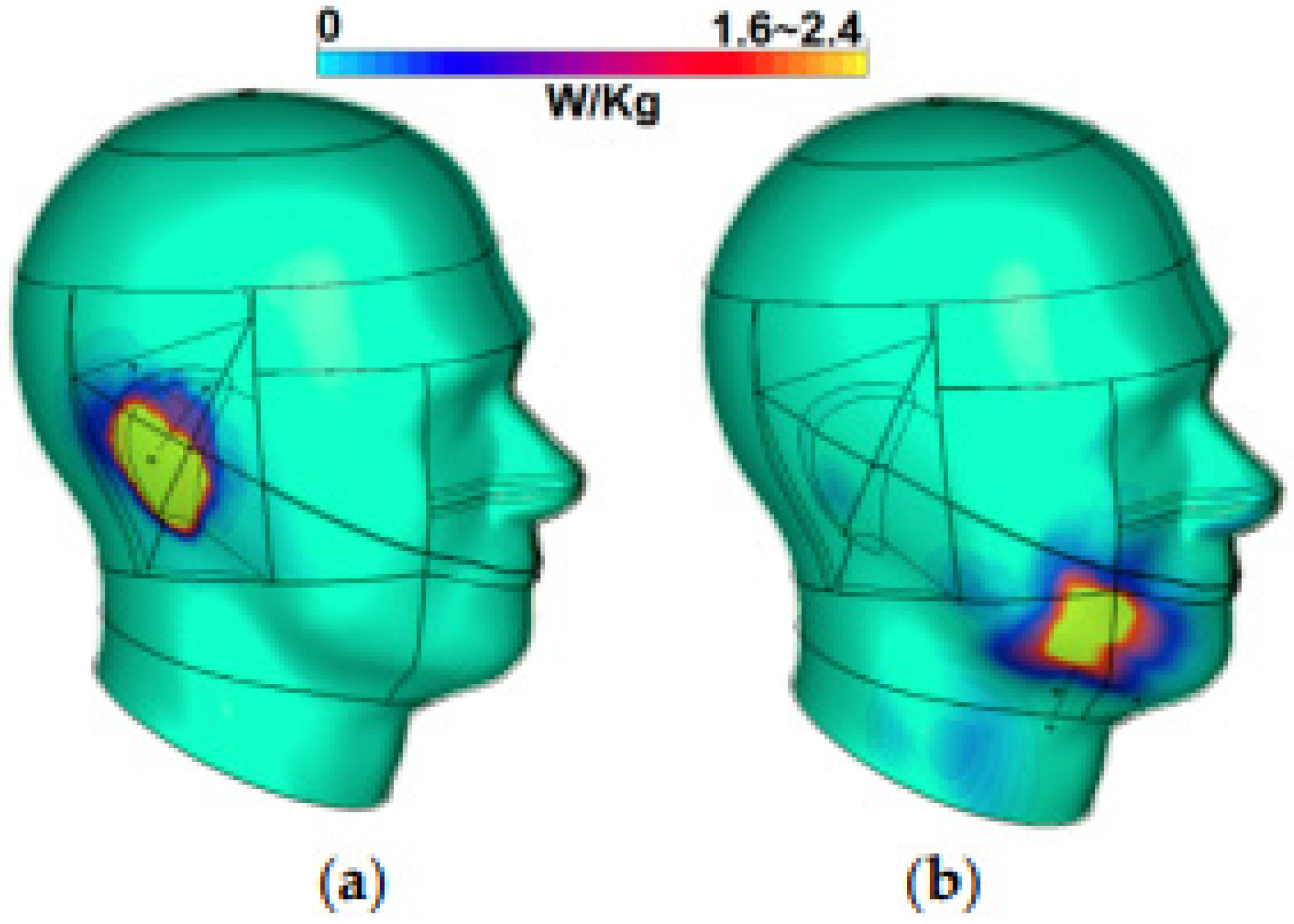
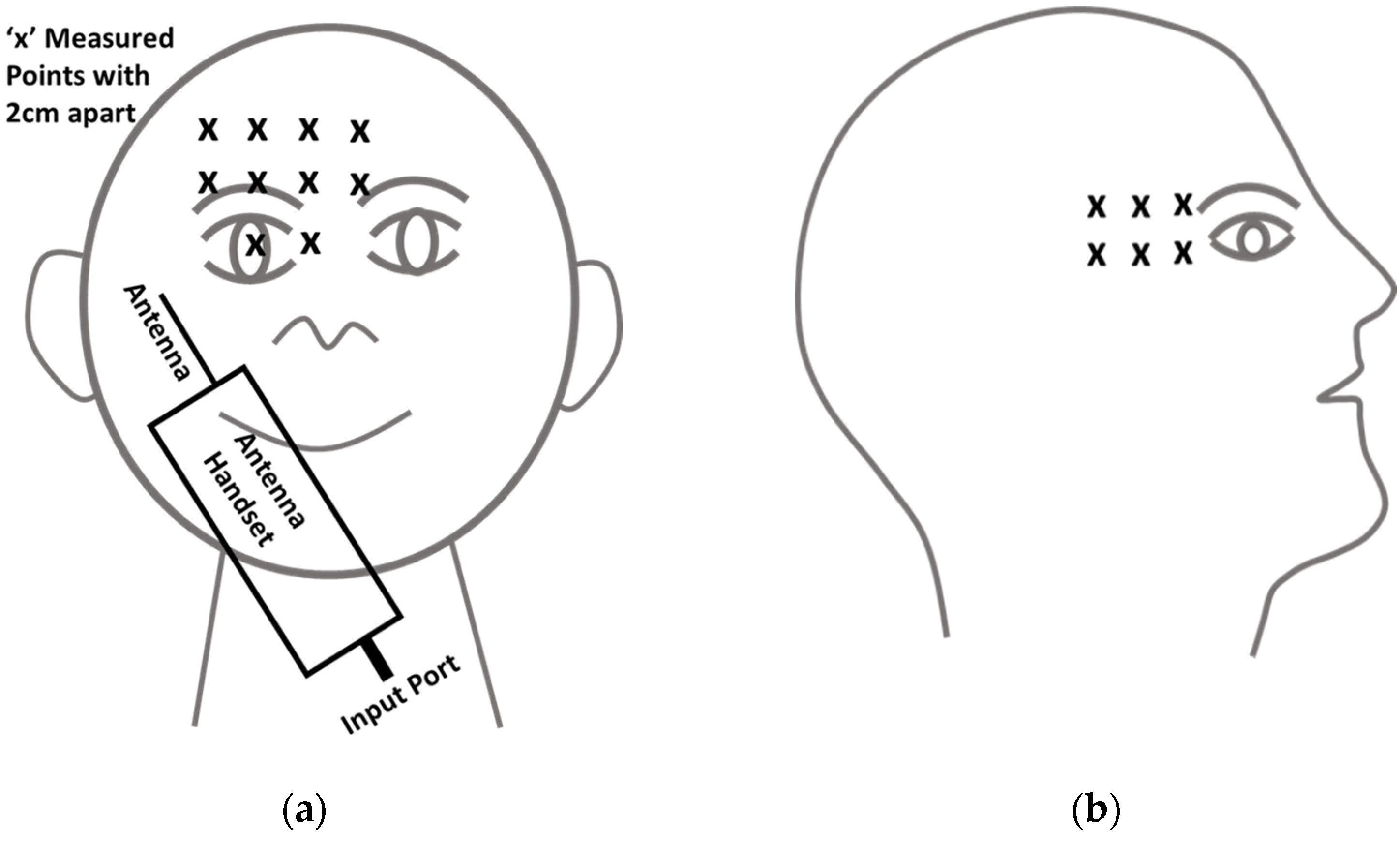
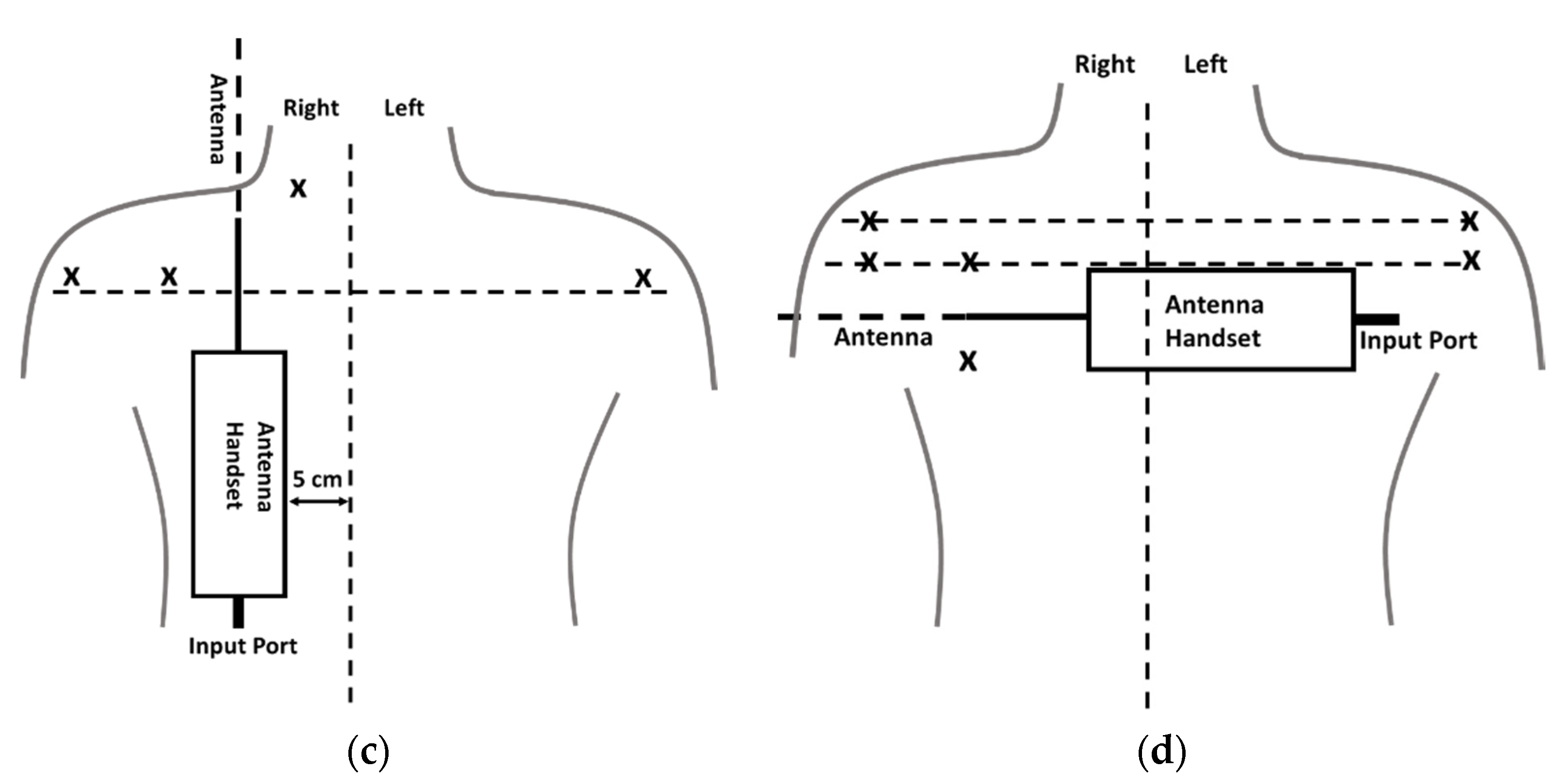

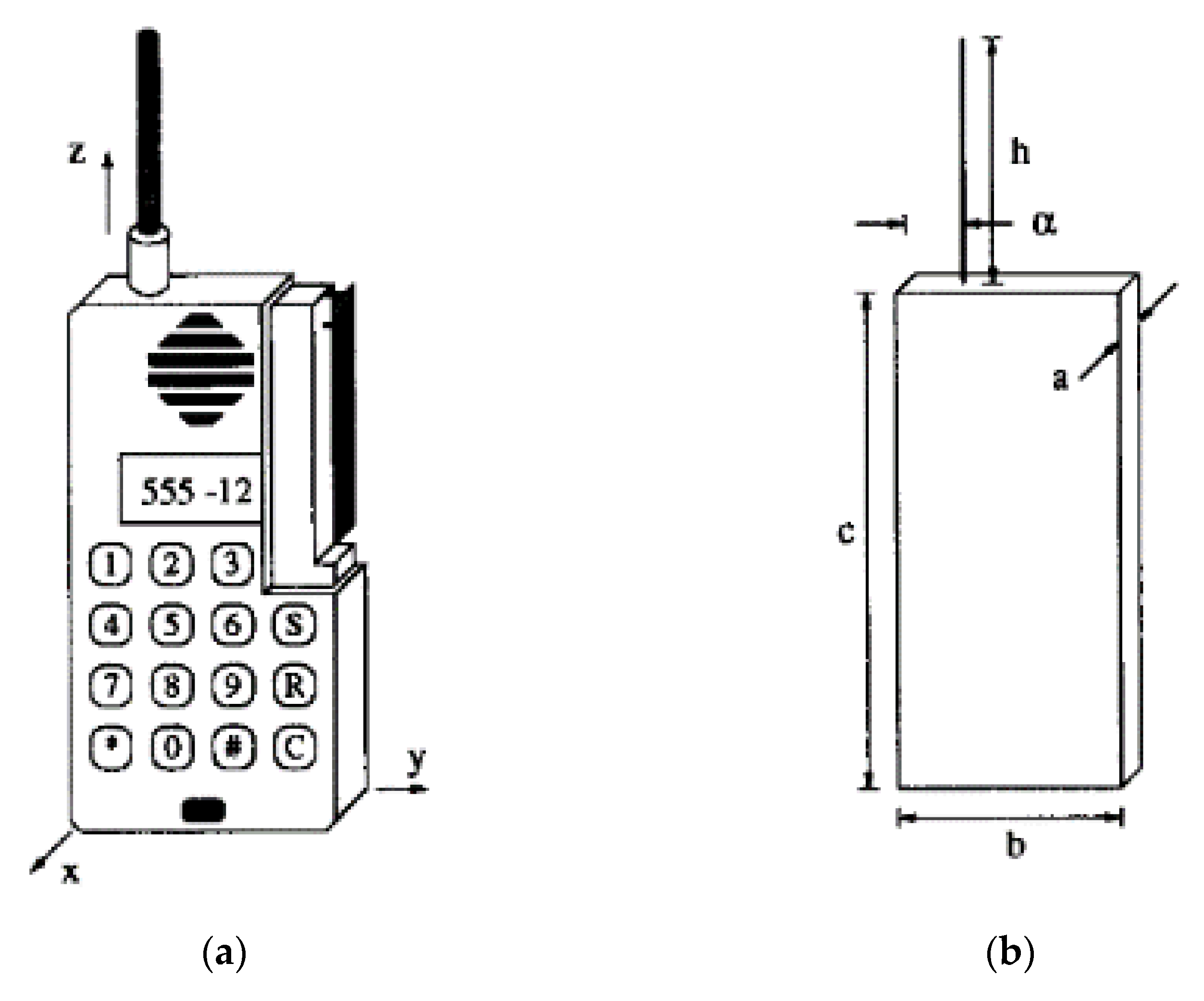
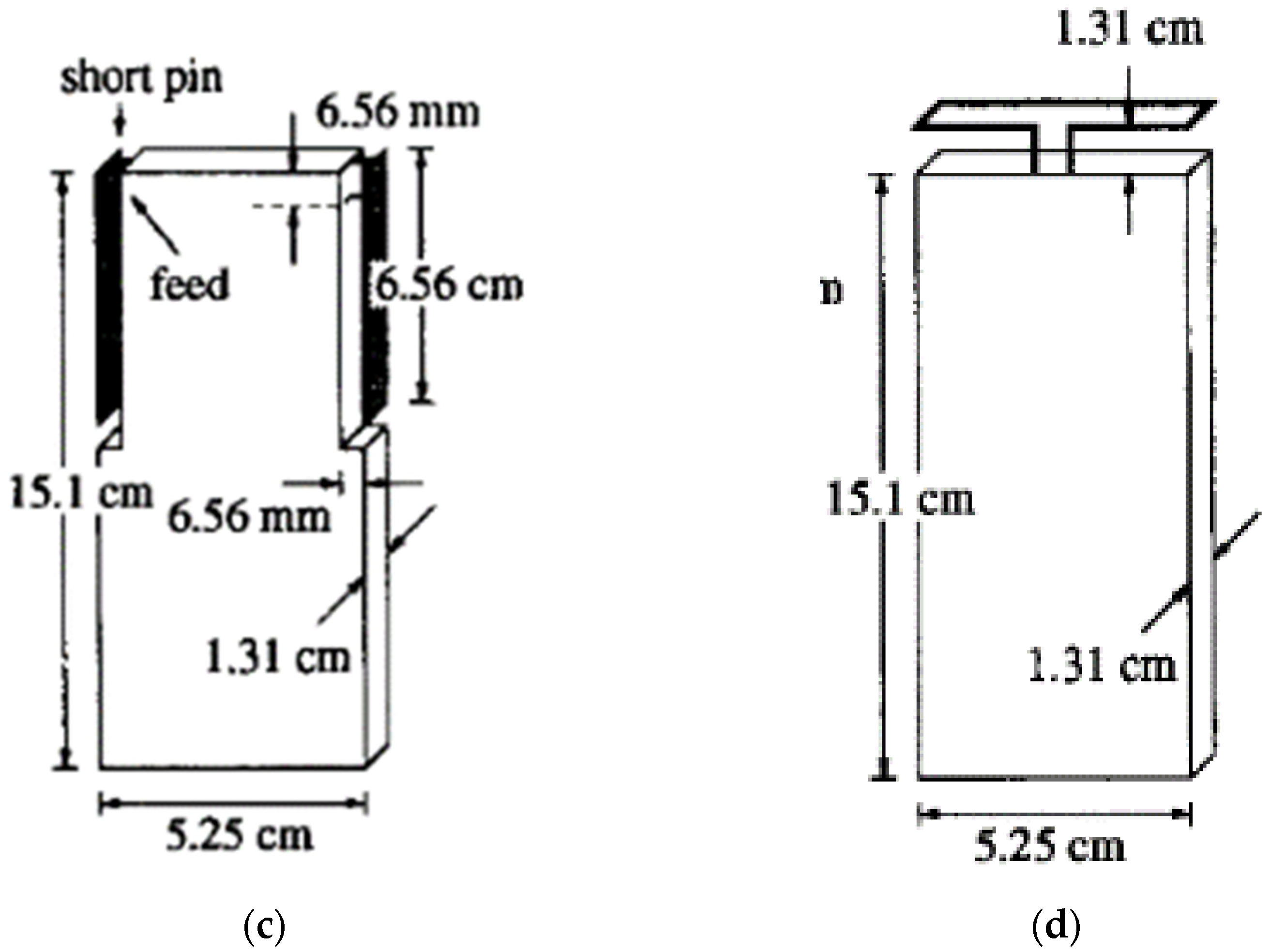
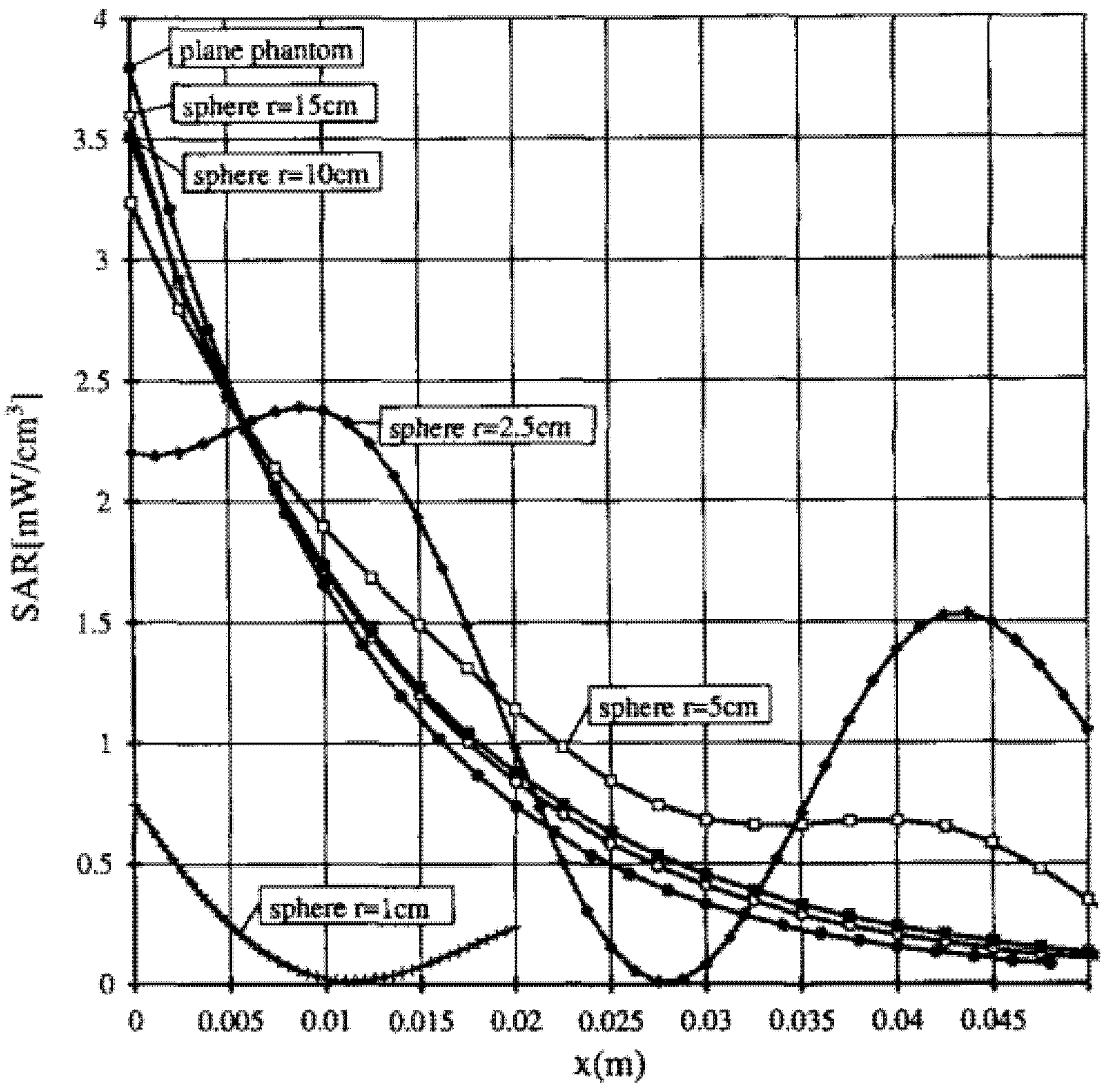
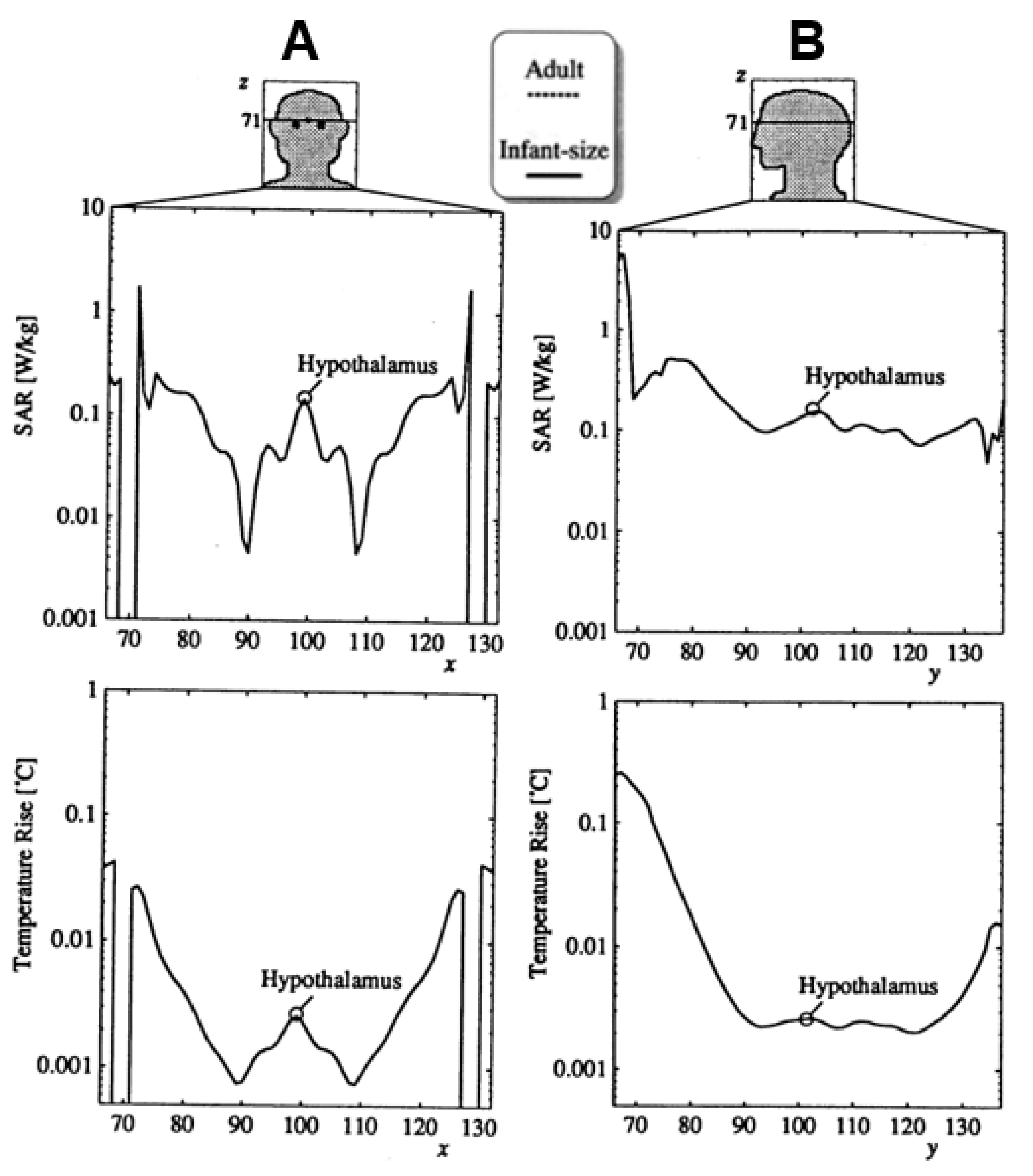




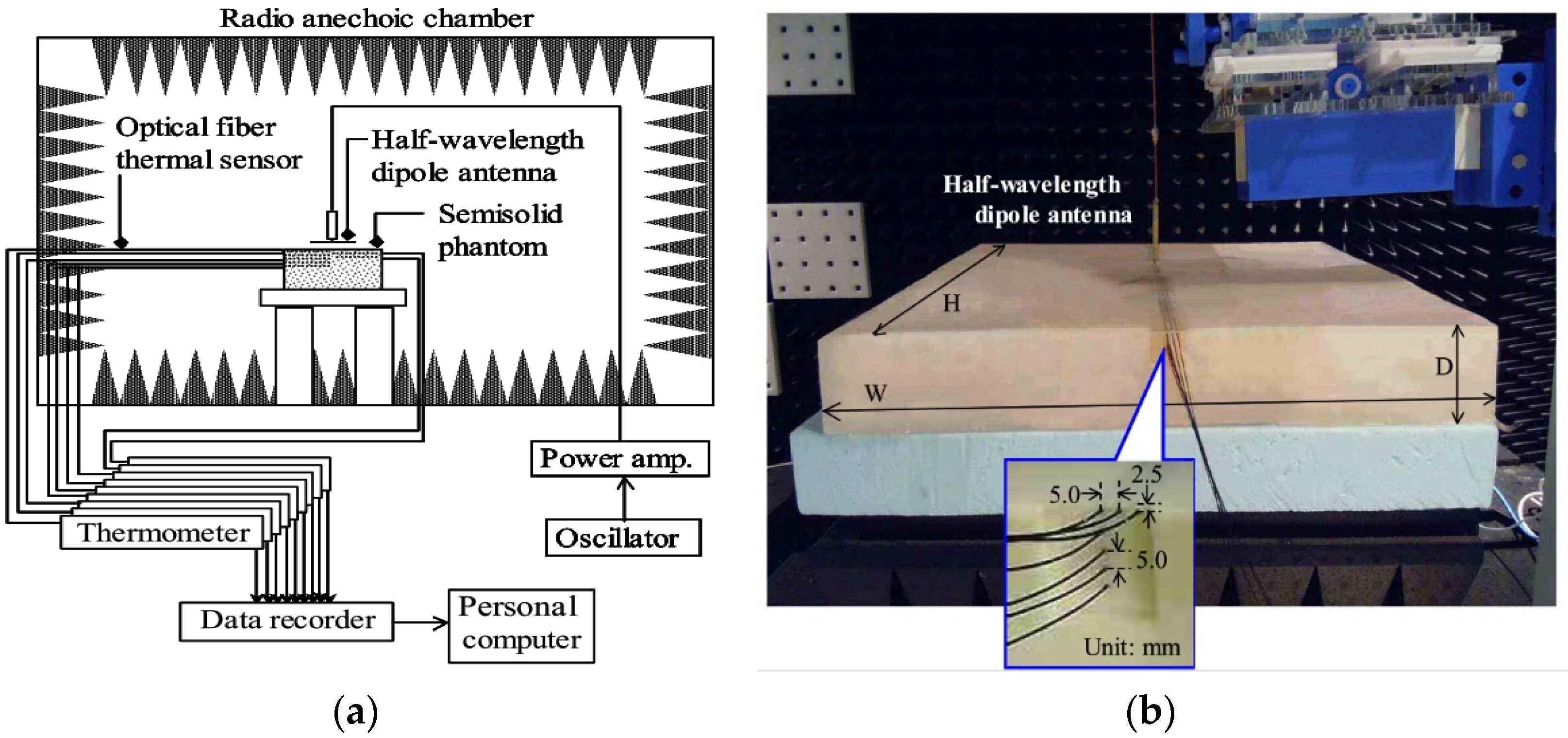
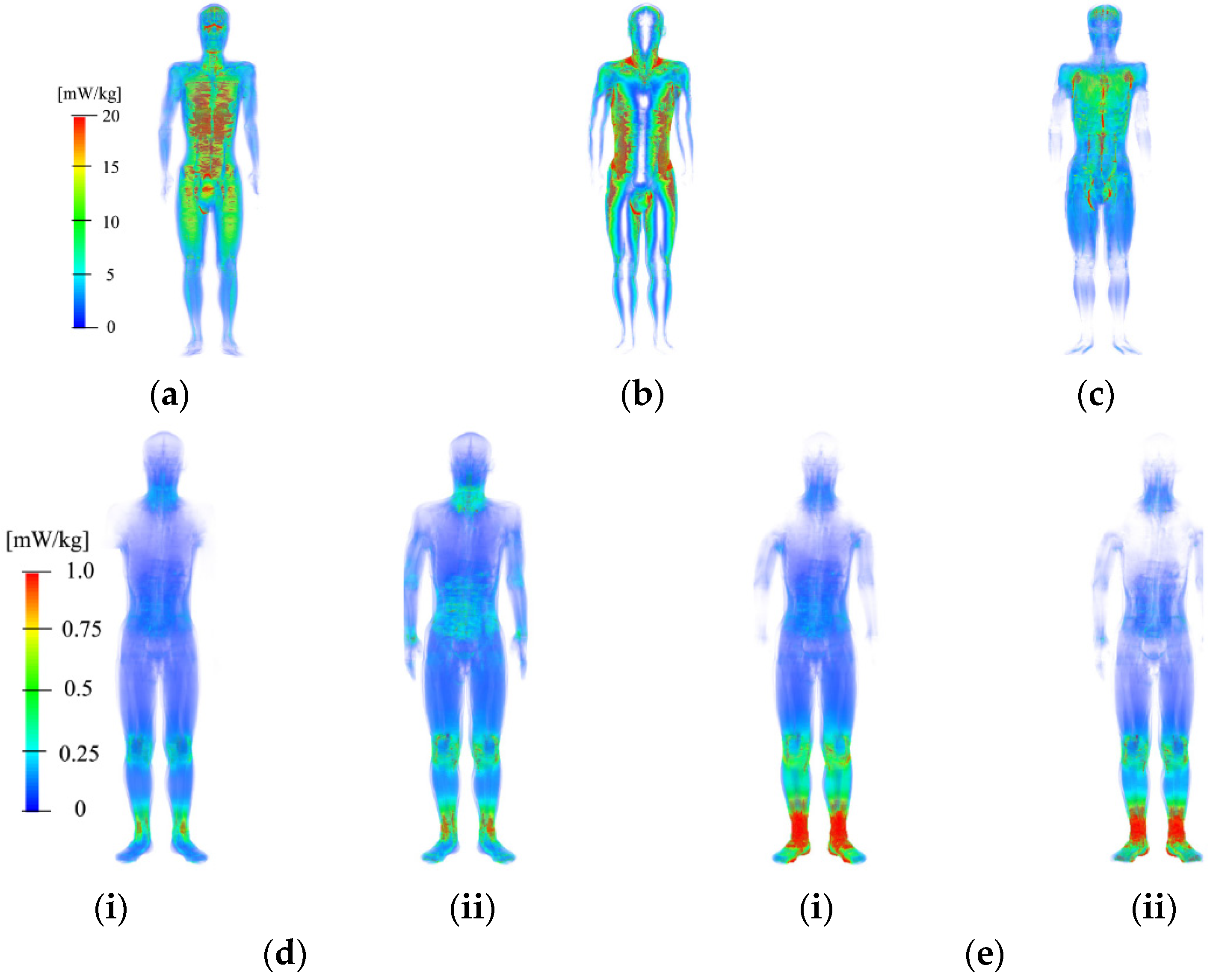
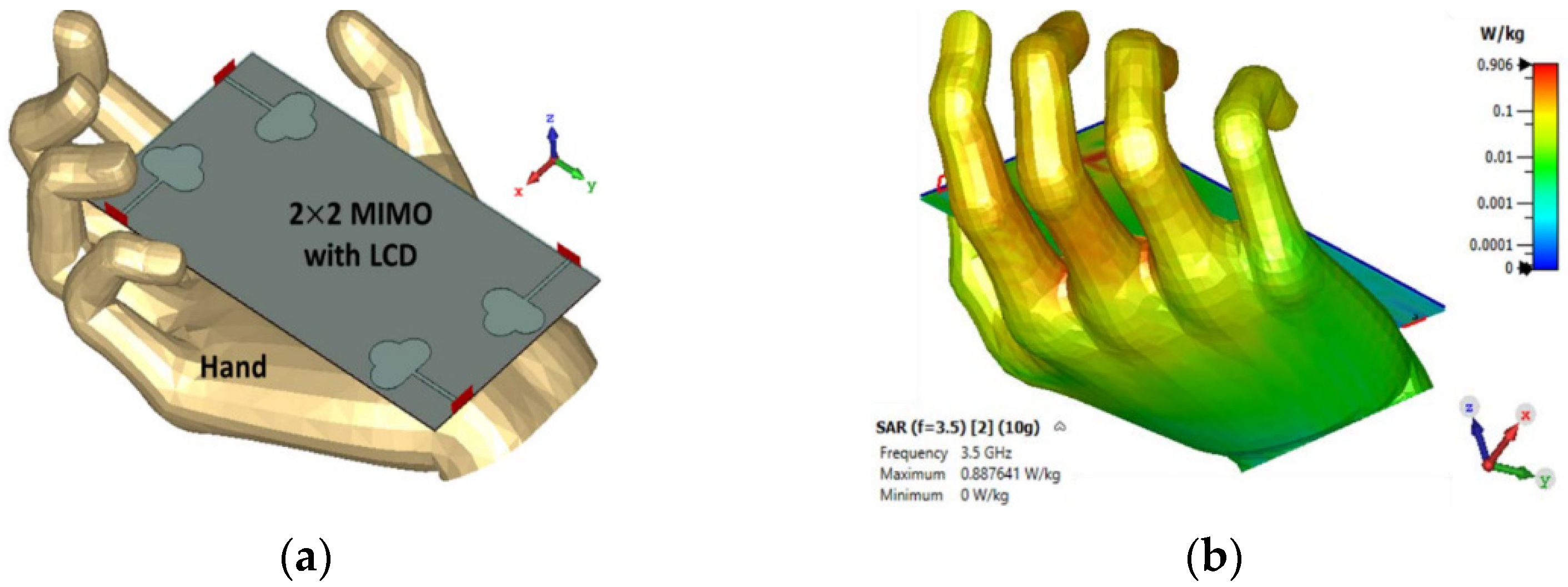
| References | Descriptions |
|---|---|
| [42] | ANSI/IEEE: averaged across any l g in the skull over any 6-min interval, 1.6 W/kg and 8 W/kg (for uncontrolled and controlled environments, respectively). |
| [44,45] | ANSI/IEEE: averaged throughout the entire body over an adequate average duration, 0.08 W/kg, and 0.4 W/kg (for both uncontrolled and controlled situations). |
| [43] | CENELEC: averaged over any l g in the skull over any 6-min interval, 2 W/kg and 10 W/kg (for uncontrolled and controlled environments, respectively). |
| [41] | CENELEC: averaged throughout the entire body over an adequate average duration, 0.08 W/kg, and 0.4 W/kg (for both uncontrolled and controlled situations). |
| [42] | NRPB: across any 6-min interval, 10 W/kg averaged over any 10 g in the cranium. |
| [42] | NRPB: throughout 15 min, 0.4 W/kg averaged over the entire body. |
| [46] | ICNIRP: 2 W/kg averaged over any 10 g in the skull for 6 min (for the general population). |
| [46] | ICNIRP: throughout 6 min, 0.08 W/kg averaged over the entire body (for the general population). |
| References | Method | Frequency Range | SAR Value |
|---|---|---|---|
| [48] | Flat surface phantom, human head, and torso | 800–900 MHz | <0.3 mW/gr |
| [49] | Head and body phantoms | 50, 150, 450, and 800 MHz | 1–2 W/kg |
| [50] | Human body model and a tensor integral using the technique of moments | 350 MHz | SAR is varied by factors ranging from 3 to 10 |
| [51] | FDTD | 350 MHz | N/A |
| [54] | FDTD | 900 MHz and 1.9 GHz | 10 W/kg averaged |
| [55] | FDTD | 900 MHz and 1.8 GHz | At 900 MHz and 1.8 GHz, 10 g of tissue produces 2.1 and 3.0 W/kg, respectively. At 900 MHz and 1.8 GHz, 1 g of tissue produces 2.3 and 4.8 W/kg per W, respectively. |
| [37] | MMP | 835 and 1900 MHz | Several SAR values were covered in different areas of the body |
| [57,58] | FDTD | 915 MHz | For 1 W of supplied power, the head SAR peaks between 2.0 and 3.8 mW/g and averages between 0.08 and 0.10 mW/g |
| [59] | FDTD | 900 MHz and 1.5 GHz | N/A |
| [40] | FDTD | 900 MHz | When compared to the maximum value obtained by the inhomogeneous phantoms, the averaged spatial peak SAR values are tiny |
| [61] | 3D-MMP | Above 300 MHz | 8 mW/g in a controlled environment 1.6 mW/g in an uncontrolled environment |
| [62] | FDTD | 1.5 GHz | 5.5 W/Kg for the skin 0.395 for the whole head <5 W/Kg for the eyeball At 1 g average peak |
| [63] | FDTD | 1.5 and 2.5 GHz | <5% for the 10 g averaged spatial-peak SAR, and considerably <20% for the 1 g averaged value |
| [64] | FDTD | 1900 MHz | The peak 1 g SAR is estimated to be around 12.64 kg−1, whereas the peak 1-voxel value is 3.7 times and 6.8 times higher than in the lower resolution model The brain’s highest 1 g value is about 2.2 kg−1 |
| [65] | FDTD | 900 MHz | N/A |
| [66] | FDTD with MoM | 64, 128, 171, and 256 MHz | The SAR value increases when the frequency of the B1 (magnetic field) field increases |
| [67] | FDTD | 1.5 GHz | Averaged SAR over any 1 g of tissues, such as bone = 1.33 W/Kg, brain = 2.27 W/Kg, muscle = 5.62 W/Kg, eyeball = 2.62 W/Kg, fat = 1.15 W/Kg, and skin = 4.47 W/Kg |
| [69] | Hybrid MoM/FDTD | 1.8–2 GH | One-element handset = 2.231 W/Kg, one-element handset with reflector sheet = 0.3814 W/Kg, two parallel dipoles = 1.2 W/Kg, two-element handset = 0.5166 W/Kg, and two-element handset with reflector sheet = 0.361 W/Kg |
| [70] | Multigrid FDTD | 900 MHz and 1.9 GHz | N/A |
| [71,72] | FDTD | 900 MHz or 1800 MHz | The 1 g spatial peak SAR value in the head was lowered by 70% when compared to the monopole |
| [73] | FDTD | 900 MHz | N/A |
| [74,75] | FDTD | 900 MHz and 2 GHz | At 900 MHz, the 1 g SAR values were determined to be between 0.87 and 1.5 W/kg At 2 GHz, the SARs are nearly doubled |
| [77] | FDTD | 900 MHz and 1.8 GHz | The 1 g average spatial peak SAR to 1.6 W/kg in the brain at 900 MHz The 10 g average spatial peak SAR to 2 W/Kg in the brain at 1.8 GHz |
| [78] | FDTD and MoM | 900 MHz and 1800 MHz | N/A |
| [79] | FDTD | 1750 MHz | N/A |
| [80,81,82,83,84,85] | FDTD | 1.8 GHz | N/A |
| [86,87,88,89] | FDTD and MoM | 430 MHz, 800 MHz, 1200 MHz, and 2 GHz | The 1 g and 10 g averaged SARs can reach 3.16 and 0.89 W/kg, respectively |
| [90] | FDTD | 835 and 1900 MHz | The spatial peak 10-g SAR of a 7-year-old Korean child head model (KR-7y) is 2.46 W/Kg, and the head average SAR is 0.203 W/Kg |
| [91] | FDTD and MoM | 300 MHz to 5 GHz | N/A |
| [92,93,94,95] | EFPS (electric field probe scanning) and FDTD | 2–3 and 5–6 GHz | N/A |
| [96] | FDTD | 900 MHz to 3.7 GHz | N/A |
| [101] | FDTD | 4 GHz | The SAR and SA results for the 41.3 and 27.4 dBm/MHz maximum peak power limits |
| [102] | EMPIRE based on the FDTD, EMPro based on the FDTD, HFSS based on the finite-element, microwave studio is based on the finite integration technique (FIT), Microstripes is based on CST’s transmission line matrix approach, and Remcom’s XFDTD is based on the transmission line matrix method | 890 MHz and 1.75 GHz | The peak 10 g average SAR at 890 MHz at right/check is 0.88 W/Kg from lab A, 0.90 W/Kg from lab B, and 1.06 W/Kg from the manufacturer. While the right/tilt is 0.44 W/Kg from lab A, 0.43 W/Kg from lab B, and 0.57 W/Kg from the manufacturer. The peak 10 g average SAR at 1.75 GHz at right/check is 0.80 W/Kg from lab A, 0.78 W/Kg from lab B, and 0.90 W/Kg from the manufacturer. While the right/tilt is 0.22 W/Kg from lab A, 0.23 W/Kg from lab B, and 0.28 W/Kg from the manufacturer |
| [103] | Lossy transmission-line device model existing in the PSPICE parts library | 915 MHz and 2.45 GHz | N/A |
| [107] | N/A | 835 MHz and 1.85 GHz | Both the SAM phantom and anatomical head models had their spatial peak 1 and 10 g SARs determined |
| [109] | ANSYS HFSS | 1.8 GHz | Maximum local SAR for the skin at a 0.1 cm thick shield is 4.85 W/Kg, while for the brain it is 0.95 W/Kg. Moreover, the maximum local SAR for the skin at a 0.2 cm thick shield is 3.9 W/Kg, while for the brain it is 0.75 W/Kg. |
| [110] | FDTD | 1.8, 2.3, 2.5, 28, and 100 GHz | Different SAR values |
| [111] | EFPS and FDTD ikaika | 300 MHz to 6000 MHz | The peak curve of the SAR 10 g has a maximum value of around 1.8 GHz |
| [114] | FEM (finite element method) | 100 kHz–10 MHz | N/A |
| [115] | FDTD | 10 MHz–6 GHz | The child voxel models’ WBA (Whole Body Averaged)-SARs exceed the fundamental restriction by no more than 20% or 0.08 W/kg. |
| [120] | Finite integral technique (FIT) | 2.81–7.23 GHz | At 3.5 GHz, it has a value of 0.88 W/Kg, which is significantly lower than the acceptable standard value of 2 W/Kg, indicating that it is safe for use in proximity-centric applications involving human bodies |
Publisher’s Note: MDPI stays neutral with regard to jurisdictional claims in published maps and institutional affiliations. |
© 2022 by the authors. Licensee MDPI, Basel, Switzerland. This article is an open access article distributed under the terms and conditions of the Creative Commons Attribution (CC BY) license (https://creativecommons.org/licenses/by/4.0/).
Share and Cite
Abdul-Al, M.; Amar, A.S.I.; Elfergani, I.; Littlehales, R.; Ojaroudi Parchin, N.; Al-Yasir, Y.; See, C.H.; Zhou, D.; Zainal Abidin, Z.; Alibakhshikenari, M.; et al. Wireless Electromagnetic Radiation Assessment Based on the Specific Absorption Rate (SAR): A Review Case Study. Electronics 2022, 11, 511. https://doi.org/10.3390/electronics11040511
Abdul-Al M, Amar ASI, Elfergani I, Littlehales R, Ojaroudi Parchin N, Al-Yasir Y, See CH, Zhou D, Zainal Abidin Z, Alibakhshikenari M, et al. Wireless Electromagnetic Radiation Assessment Based on the Specific Absorption Rate (SAR): A Review Case Study. Electronics. 2022; 11(4):511. https://doi.org/10.3390/electronics11040511
Chicago/Turabian StyleAbdul-Al, Mohamed, Ahmed S. I. Amar, Issa Elfergani, Richard Littlehales, Naser Ojaroudi Parchin, Yasir Al-Yasir, Chan Hwang See, Dawei Zhou, Zuhairiah Zainal Abidin, Mohammad Alibakhshikenari, and et al. 2022. "Wireless Electromagnetic Radiation Assessment Based on the Specific Absorption Rate (SAR): A Review Case Study" Electronics 11, no. 4: 511. https://doi.org/10.3390/electronics11040511
APA StyleAbdul-Al, M., Amar, A. S. I., Elfergani, I., Littlehales, R., Ojaroudi Parchin, N., Al-Yasir, Y., See, C. H., Zhou, D., Zainal Abidin, Z., Alibakhshikenari, M., Zebiri, C., Elmegri, F., Abusitta, M., Ullah, A., Abdussalam, F. M. A., Rodriguez, J., McEwan, N. J., Noras, J. M., Hodgetts, R., & Abd-Alhameed, R. A. (2022). Wireless Electromagnetic Radiation Assessment Based on the Specific Absorption Rate (SAR): A Review Case Study. Electronics, 11(4), 511. https://doi.org/10.3390/electronics11040511















